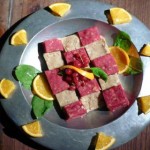I recently suffered a bread failure. A massive, heavy, doorstopper type bread failure. Why? If you check out my post last year, I recommended mixing in a bowl and then transferring it to the beloved (dollar store) plastic containers to rise. A mixing bowl prevents you from dumping in too much flour, whereas a straight sided container makes it difficult to judge random quantities. That was my mistake, and I think the sourdough may be a bit iffy.
So I have these unusable loaves. What would you have done with them in the Regency? Used them. Nothing was wasted. Doubtless I would have given them to the poor who would have obsequiously tugged their forelocks and stored them for the coming revolution when they’d thrown all the cobblestones. Or I would have used them to cook with. Grated bread, or even chunks added to liquids, is a useful thickener. So after receiving much advice on Facebook (use as poultices, get chickens, feed ducks) I went hunting for historical old bread recipes.
Starting off with Hannah Glasse, The Art of Cookery, made Plain and Easy (1747), here’s a Baked Bread Pudding (although she doesn’t specify stale bread):
Take the Crumb of a Penny-loaf, as much Flour, the Yolks of four of four Eggs and two Whites, a quarter of a Pound of Sugar, a Tea Spoonful of Ginger, half a Pound of Raisins stoned, half a Pound of Currants clean washed and picked, a little Salt; mix first the Bread and Flour, Ginger and Salt and Sugar, then the Eggs, and then as much Milk as will make it like a good Batter, then the Fruit, butter the Dish, and pour it in and bake it.
 Many recipes I found transformed the humble loaf, the staple food in the west for centuries, into a luxury item with the addition of exotic, expensive spices, such as this Gingered Bread from the Tudor era colored with cochineal and flavored with ginger and peppercorns.
Many recipes I found transformed the humble loaf, the staple food in the west for centuries, into a luxury item with the addition of exotic, expensive spices, such as this Gingered Bread from the Tudor era colored with cochineal and flavored with ginger and peppercorns.
A visit to Gode Cookery turned up A Quaking Pudding from the sixteenth century very similar to Hannah Glasse’s, but flavored with rosewater and walnuts. This is a fabulous site if you’re interested in historical food. Check out the Lombard Brewet, chicken stewed in almond milk, thickened with bread and eggs, or the fifteenth century Payne Foundow, a bread pudding made with wine. You can also discover Divers Pretty Things Made Of Roses & Sugar from the sixteenth century (no bread, a diversion).
But in the end I have decided to make a genuine British Bread and Butter Pudding using the raisin walnut loaves, and letting everything soak a long, long time, and something like this Aragula, Bacon, and Gruyere Bread Pudding (I have no aragula or gruyere, but you get the idea) with the rest. Should be yummy!
 Before I ask leading questions, check out AllRomanceEBooks where A Most Lamentable Comedy is priced at ONE DOLLAR!! and you can also buy The Malorie Phoenix. Go grab them while they’re hot and the heroes are sorta like my bread if you know what I mean and I think you do.
Before I ask leading questions, check out AllRomanceEBooks where A Most Lamentable Comedy is priced at ONE DOLLAR!! and you can also buy The Malorie Phoenix. Go grab them while they’re hot and the heroes are sorta like my bread if you know what I mean and I think you do.
Have you had any notorious cooking failures or successes recently? Or, if you were a Regency lady, what would you do with my rock-hard bread?


Since my family and I have been sick so much, I’ve been making lots of soup. Some recent favorites: chicken with matzoh balls (fussy, took longer than I expected but VERY comforting), mulligatawney with lentils (spent a small fortune on spices I didn’t already own, but that’s OK because I’m definitely making it again). So far no failures.
I’d do the same as you. Hope those bread pudding recipes turn out as well as they sound!